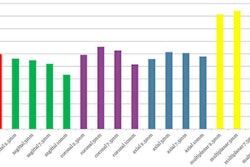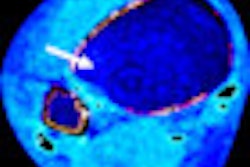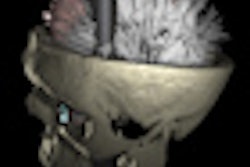SAN FRANCISCO - Screening lower-risk individuals snuffs out the benefit of CT lung cancer screening while multiplying the costs and risks of the technology, according to a presentation on Tuesday at the 2012 American Thoracic Society (ATS) meeting.
The digital ink is barely dry on new guidelines advocating a conservative approach to lung cancer screening (Journal of the American Medical Association, May 20, 2012), but tongues are already wagging about its conclusions. The guidelines have their detractors -- principally among patient advocates who want more screening -- as well as supporters, who cite a lack of evidence in the literature favoring a more liberal approach to screening.
Dr. Gerard Silvestri, professor of pulmonology and critical care medicine at the Medical University of South Carolina, takes the cautious approach, as he explained in a talk that surveyed the risks and benefits of lung cancer screening from a decade of lung cancer studies.
For heavier smokers only
The guidelines, from the American College of Chest Physicians (ACCP) and the American Society of Clinical Oncology (ASCO), would restrict CT screening to patients ages 55 to 74 who are current smokers or quit within the past 15 years, without hemoptysis or weight loss, and who are medically fit to undergo surgery. Screening would occur once a year for three years in a row.
"We want to keep the risk up so you don't have to do as many screens to detect the cancer," Silvestri said. "Some of the push, some of the tension to screen more patients with high-risk pulmonary diseases may have the opposite effect to what you think it will have. You'll get more cancers, but the patients may not be as fit. Patients may not survive the surgery, and they may have competing causes of death from coronary artery disease, etc."
Who did the National Lung Screening Trial (NLST) have to recruit to come up with its impressive 20% mortality gains? Compared to U.S. Census data, the NLST population was a little younger, a little more likely to be former rather than current smokers, and on the whole more educated than the population of screening-aged smokers, he said.
When considering whom to screen, an important consideration is the general population and how it fits into the study population, he said. And it's important to consider, demographically speaking, what is the "sweet spot" for CT screening -- the population for whom it is most effective. Several societies have put out similar lists of who is likeliest to benefit from CT lung screening, including the National Comprehensive Cancer Network (NCCN).
The NCCN guidelines are as follows:
- Category 1 (high-quality evidence):
- High-risk individuals: 55-74 years of age
- 30 pack-year smoking history and if former smoker quit within 15 years
- Category 2B (weak evidence):
- Individuals ages 50 and older with at least 20 pack-years of smoking history and one additional risk factor: cancer history, lung disease, family history of lung cancer, radon exposure, or occupational exposure
"We want [screening subjects] to be super-high-risk for lung cancer, but we want them to be at low risk for poor outcomes from surgery, because you'll lose your benefit if you have patients at high risk for poor outcomes," he said.
"On the other side, you don't want someone who's low-risk for cancer, because all they're going to get are the risks of having a workup for a noncalcified nodule, which, admittedly, had a very low rate of complications in the NLST trial," he said. "And you don't want someone, even if they're not a poor surgical risk, to have other, competing causes of death." High risk means the screening subjects should still be smoking, or have recently quit, he said.
Why smoking is important
For screening to be effective, smoking or having recently quit is important because risk drops so quickly after smoking cessation, Silvestri said. One analysis (Peto et al, British Medical Journal, 2000) compared the relative risk of lung cancer among current versus former smokers. The study found that current smokers had 33 times the relative risk of developing lung cancer compared to nonsmokers.
That risk dropped to 22 times the normal risk 10 years after quitting, to 14 times the normal risk 10 to 19 years after quitting, to seven times the normal risk 20 to 29 years after quitting, and, finally, to only three times the normal risk 30 or more years after quitting. The same exponential risk reduction occurs when screening is offered to younger patients.
Other factors also add to the risk of cancer from smoking, and the benefits of treatment must always be balanced against the risks of intervention, he said.
Factors that increase lung cancer risk, other than smoking
|
Risk of surgery for lung cancer
|
The literature shows that even when the risk of cancer death is high, the risks of surgery can tilt the balance in favor of nonintervention. For example, surgery is difficult in patients exposed to asbestos.
The NLST demonstrates by far the lowest mortality rate from lung cancer surgery, at about 1%, but it's unclear how many of the surgeries were thoracotomies for lung cancer and how many may have been thoracoscopies, Silvestri said. And in NLST, 40% of the patients were younger than 60 and only 8% were older than 70, pointing again to the study's younger, healthier population, which was treated in high-volume centers, Silvestri said.
In terms of explaining risk to patients, the 2008 study in the Annals of Thoracic Surgery is by far the most solid source, with its 4.8% perioperative mortality rate and cohort of 512,000 patients, Silvestri said.
"If we're going to screen younger, healthier patients ... and surgery's being done in a good center, we're doing the right thing," he said.
A 2001 study in the New England Journal of Medicine showed that high-volume hospitals performing 67 to 100 procedures per year had double the patient survival of hospitals that performed from one to eight procedures annually. This very important study shows that patients in high-volume centers get the benefits -- but not all patients will end up in high-volume centers, he said.
In cooperation with other organizations, the American Lung Association in its endorsement of screening last month recommended that screening, follow-up, and treatment be conducted in high-volume centers of excellence that are better equipped to diagnose and treat the disease.
"While that's a great recommendation, the ads that you see all over the U.S. now are in small community hospitals with CT scanners in the back of a truck behind the mall," Silvestri said.
Cost efficacy
Like the benefits of screening, estimates of the cost-effectiveness of CT screening and care are all over the map depending on the study and many other factors, making it hard to evaluate. But more and better data are coming, he said.
The lowest estimate by far of lung screening's cost, from 2003 Early Lung Cancer Action Project (ELCAP) data, calculates an incremental cost of $2,500 per quality-adjusted life year (QALY), a figure that exceeds the commonly accepted U.S. threshold of $50,000 per QALY only if the rate of overdiagnosis exceeds 50% (Chest, 2003). However, the model doesn't account for unnecessary surgery or any other testing for benign disease. It also doesn't account for nonadherence -- for example, when a patient fails to appear for his second annual screening round.
Mahadevia et al put together a more complex model in their study (JAMA, 2003), creating a Markov model of 100,000 hypothetical patients followed for more than 20 years. They factored in a 50% shift toward earlier-stage disease due to screening, a nonadherence rate of 6.5%, and a CT scan cost of $300 to arrive at an incremental cost-effectiveness of $116,000 per QALY for smokers, which ballooned to $558,000 per QALY for quitting smokers and topped out at a whopping $2,322,700 per QALY for former smokers, Silvestri said.
Health Affairs (2012) estimated $19,000 per life year saved as a result of screening, a low estimate that seems unlikely, Silvestri said. Preliminary data in the Cancer Letter (2011) showed a cost of $38,000 per QALY.
McMahon et al (Journal of Thoracic Oncology, 2011) estimated an overall cost-effectiveness of $126,000 to $169,000 for screening depending on current smoking status. For high-risk smokers alone the estimate was $75,000 -- a figure that doubled for smokers who had quit. The cost of annual combined screening and smoking cessation therapies amounted to $130,000 to $150,000 compared to cessation therapy alone.
"I want to review this whole idea that we need to somehow couple smoking cessation with a 'teachable moment' for lung cancer screening," he said. "I'm sorry, but I can't get my arms around it. [Screening] is just an incredibly expensive way to get at smoking cessation, and the idea of a teachable moment is problematic."
By itself, smoking cessation is one of the cheapest interventions available for extending life, he said, at $1,300 per QALY. This is compared to, say, a coronary artery bypass graft in the left main artery ($6,000), cervical cancer screening every four years ($11,000), screening mammography for a 50-year-old woman ($18,000), hemodialysis for end-stage renal disease ($50,000), or screening mammography in a woman younger than 50 ($232,000). The authors based these estimates on best-case scenarios, Silvestri said.
But combined with lung cancer screening, smoking cessation only makes diagnosis more expensive, and if that weren't enough, screening doesn't even help people quit smoking.
Using strong data from NLST, the cost-effectiveness working group (which includes Silvestri) last year came up with a preliminary, back-of-the-envelope estimate of an incremental cost-effectiveness ratio of $38,000 (cost of screening, $1,520; life years gained, 0.040) that was presented at last year's RSNA meeting. Now that the final numbers are nearing release, Silvestri said he can't divulge the final cost per QALY.
"It's not $38,000 -- I'll leave it at that," he said.
In summary, he said, stick to screening people within the NLST guidelines, and you get bonus points if the patients who meet the smoking history criteria are a little younger and healthier than average. "Do not screen, for now, anyone outside the NLST criteria with no exceptions -- that's my view," Silvestri said.
Whom do we really screen?
"Who knows, who cares, and who makes policy decisions based on cost anyway in the U.S.?" he quipped.



















